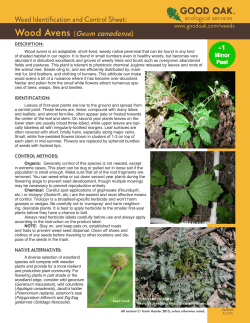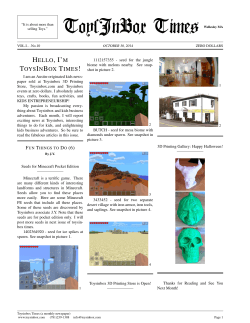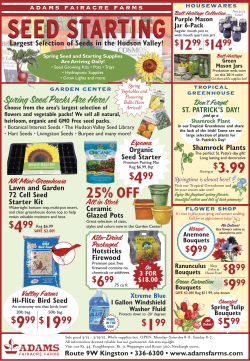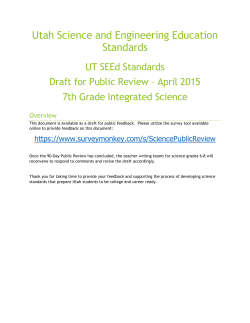
Plants Lesson Plan SISSI blank
Lesson: Plants and their Environments Grade Level: One and Kindergarten Subject Area: Life Science Core Area: Plants and their Environments; Exploring Organisms and the Environment Lesson Objective: Students discuss how plants are different from and the same as people. Differences in movement and structures will be explored. Time-lapse videos of plants in motion will show how they move as they grow and sometimes move in response to changes in the environment. Students will look closely at multiple examples of plant parts, describe their properties, and brainstorm the role or function of each plant structure. Similarities between the basic needs and the life cycles of plants and people will be discussed. Students will model the life cycle of a flowering plant, then sort seeds according to physical properties and the way they are dispersed. They will conduct structured investigations about seed dispersal and see how seeds have inspired inventions. The lesson can be extended to allow time to invent something based on a seed or other plant part. 2005 Standards Correlation: Grade Kindergarten: Characteristics of Organisms (Life Science) Standard K-2: The student will demonstrate an understanding of the characteristics of organisms. Indicators K-2.1 Recognize what organisms need to stay alive (including air, water, food, and shelter). K-2.2 Identify examples of organisms and nonliving things. K-2.3 Match parents with their offspring to show that plants and animals closely resemble their parents. K-2.4 Compare individual examples of a particular type of plant or animal to determine that there are differences among individuals. K-2.5 Recognize that all organisms go through stages of growth and change called life cycles. Grade 1: Plants (Life Science) Standard 1-2: The student will demonstrate an understanding of the special characteristics and needs of plants that allow them to survive in their own distinct environments. Indicators: 1-2.1 Recall the basic needs of plants (including air, water, nutrients, space, and light) for energy and growth. 1-2.2 Illustrate the major structures of plants (including stems, roots, leaves, flowers, fruits, and seeds). 1-2.3 Classify plants according to their characteristics (including what specific type of environment they live in, whether they have edible parts, and what particular kinds of physical traits they have). 1-2.4 Summarize the life cycle of plants (including germination, growth, and the production of flowers and seeds). Copyright © 2014 by the Board of Trustees of the University of South Carolina Page 1 of 4 2014 Standards Correlation: Grade Kindergarten: Exploring Organisms and the Environment Standard K.L.2: The student will demonstrate an understanding of organisms found in the environment and how these organisms depend on the environment to meet those needs. K.L.2A. Conceptual Understanding: The environment consists of many types of organisms including plants, animals, and fungi. Organisms depend on the land, water, and air to live and grow. Plants need water and light to make their own food. … Organisms live in areas where their needs for air, water, nutrients, and shelter are met. Performance Indicators: Students who demonstrate this understanding can: K.L.2A.1 Obtain information to answer questions about different organisms found in the environment (such as plants, animals, or fungi). K.L.2A.2 Conduct structured investigations to determine what plants need to live and grow (including water and light). K.L.2A.6 Obtain and communicate information about the needs of organisms to explain why they live in particular areas. Grade One: Plants and Their Environments Standard 1.L.5: The student will demonstrate an understanding of how the structures of plants help them survive and grow in their environments. 1.L.5A. Conceptual Understanding: Plants have specific structures that help them survive, grow, and produce more plants. Plants have predictable characteristics at different stages of development. Performance Indicators: Students who demonstrate this understanding can: 1.L.5A.1 Obtain and communicate information to construct explanations for how different plant structures (including roots, stems, leaves, flowers, fruits, and seeds) help plants survive, grow, and produce more plants. 1.L.5A.2 Construct explanations of the stages of development of a flowering plant as it grows from a seed using observations and measurements. 1.L.5B. Conceptual Understanding: Plants have basic needs that provide energy in order to grow and be healthy. Each plant has a specific environment where it can thrive. There are distinct environments in the world that support different types of plants. These environments can change slowly or quickly. Plants respond to these changes in different ways. Performance Indicators: Students who demonstrate this understanding can: 1.L.5B.1 Conduct structured investigations to answer questions about what plants need to live and grow (including air, water, sunlight, minerals, and space). 1.L.5B.2 Develop and use models to compare how the different characteristics of plants help them survive in distinct environments (including deserts, forests, and grasslands). 1.L.5B.3 Analyze and interpret data from observations to describe how changes in the environment cause plants to respond in different ways (such as turning leaves toward the Sun, leaves changing color, leaves wilting, or trees shedding leaves). Resources with structured investigations to determine what plants need to live and grow In Traveling Science • FOSS Kit 2360: New Plants • Book: How a Seed Grows (in FOSS literature kit 3189) • STC Kit 1206: Plant Growth and Development • Book: Grow It Again (in STC literature kit 3202) Copyright © 2014 by the Board of Trustees of the University of South Carolina Page 2 of 4 Online Source of downloadable activities, booklets, and background information on Plants http://www.saps.org.uk/primary/teaching-resources/88-primary-article-one Materials for • • • • • • • • • • • • • this lesson: Variety of live plants in pots, at least 1 with flowers Collections of roots, stems, leaves, flowers, fruits, and seeds Small white boards for brainstorming Containers of seeds for sorting Divided plastic plates and/or labeled sorting mats Plant life cycle pieces in zip-locks Pocket chart with plant part labels and colors Plant life cycle “masters” on poster board Video of time-lapse sequences PowerPoint show with links to videos Fan, seeds on string Clear plastic cups, pitcher of water, cups of assorted seeds Wolf puppet, knit slipper, large bins of different seeds to test Activities: 7Es, Science and Engineering Practices, and Cross Cutting Concepts 7E Elicit Engage Explore Explain Procedures SEPs 1. Brainstorm 3 ways that plants and people are different. Fill in a Double Bubble Thinking Map. 2. Brainstorm three ways that plants and people are alike. Fill in the rest of the double bubble map. Do plants move? Brainstorm with your group about ways that plants can move. Watch time-lapse video of plants moving as they grow. Notice how some plants move in response to changes in the environment. Examine plant specimens on your table. Describe properties of the assigned plant structure, then brainstorm how that part helps the plant to live or produce more plants. Share your ideas with the class. Use plant puzzle pieces to model the lifestyle of a plant. Examine baby and toddler plants and sort puzzle pieces by color. Then construct a child, a teenage, and a mature adult plant. Look at a collection of different seeds and describe their properties. Sort seeds by properties. Note that seeds are designed to get away from their parents. Plants and people differ in care of babies. 1. During the discussion of how plants and people are different, make sure students realize that plants make food; they don’t eat food like people do. The nutrients they get from soil and fertilizer are minerals not food that provides energy. Copyright © 2014 by the Board of Trustees of the University of South Carolina CrossCut Page 3 of 4 Elaborate Evaluate Extend 2. During the discussion of how plants and people are alike, make sure students realize that plants are alive and grow. Then, mention that both plants and people go through a life cycle. 3. Compare life cycle of a plant to human life cycle. Be sure they know flowers come before fruits. 4. Plants try to get rid of their babies, and they try to get them as far away as possible! If overcrowded, plants may not get the sun, water, space, air, & nutrients they need. Ask students to predict and test which type of seed will work best with each method of seed dispersal Explore 3 methods of seed dispersal: wind (an electric fan), water (small cups of water), and fur (an old sock). Watch videos of seed dispersal and of human inventions inspired by seeds. Ask questions such as: • How is a root like an anchor? • How is a seed like a suitcase? • How is a stem like a straw? • How is a flower like a butterfly? • How is a leaf like an oven? • How are plants like people? Students work together to match seeds with the correct fruit or vegetable (or pictures of them). Students conduct investigations to determine what plants and seeds need to live and grow. Students design an invention based on a seed or other plant part. Students compare how the different characteristics of plants help them survive in distinct environments and match available plants to pictures of environments in which they typically grow. Copyright © 2014 by the Board of Trustees of the University of South Carolina Page 4 of 4
© Copyright 2025









